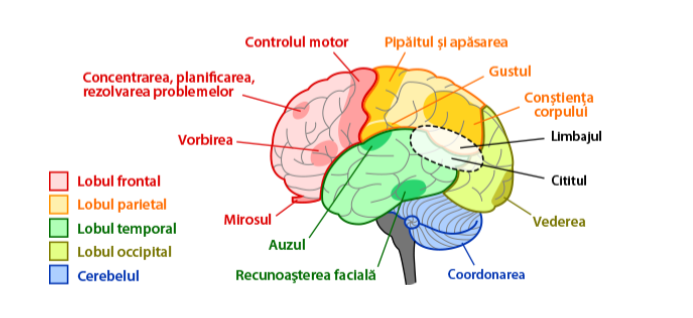The structure of the human brain
The extreme performance of the brain is based on the exorbitant number of connections between the billions of nerve cells. The brain is divided into certain functional centres, it is organised individually and very specifically, and constant reorganisation takes place.
Content
The central nervous system (CNS) consists of two parts: the brain and the spinal cord, which connects the brain to the periphery, such as muscles.
The brain controls the body's vital functions, enables emotional experience and thought, processes sensory impressions, and much more. The human brain weighs an average of 1,400 grams and is made up of billions of nerve cells (neurons) that constantly communicate with each other and exchange information. This happens by means of electrical impulses. However, what is special about the brain is not the large number of neurons, but the exorbitant number of nerve connections (synapses) between these neurons. The number of synapses in the brain is estimated at an incredible 100 trillion.
The brain consists of two halves (hemispheres), which are connected by the so-called bar (corpus callosum). Certain functional centres are found in both halves of the brain, but other centres exist only once - such as the language centre. Whether a certain function is located more in the left or right side of the brain varies from person to person. However, in principle, the right side of the body is controlled by the left hemisphere, and the left side of the body is correspondingly controlled by the right hemisphere. Many of the brain's most complex functions, such as behaviour or learning, are still rudimentarily understood. However, there is also research and knowledge about important factors, such as the role of feedback or attention, that affect specific functions such as behaviour or learning.
Briefly, the brain is divided into:
The cerebrum with the cerebral cortex
The diencephalon with the pituitary gland and the thalamus
Brainstem with midbrain
Cerebellum
The cerebral cortex
The cerebral cortex is the largest and most developed part of the brain, accounting for 80% of the brain's mass, but it is also the youngest. Its cortex is strongly folded, which considerably increases its surface area.
Anatomically, the brain can be divided into the following areas:
the frontal lobe is responsible for complex mental functions, such as planning behavior, movements or actions. It is the youngest part of the cerebral cortex and is more developed in humans than in other mammals.
the parietal lobe (at the back) is mainly responsible for processes related to attention and sensory perceptions that are received through the senses, such as sight, hearing, smell, taste or touch.
the temporal lobe (lateral) contains various functions, such as the speech center (Wernicke center), visual working memory or recognition of faces and objects.
the occipital lobe is responsible for processing visual stimuli.

Cerebellum
The cerebellum works unconsciously, that is, it cannot be influenced voluntarily, and belongs to the motor system. It sets up highly coordinated movement processes such as balance. The cerebellum plays a key role in learning, particularly in the implicit learning of motor skills. Automatic and well-trained movement programs can be accessed without the activation of conscious thought, such as walking or grasping, coordinated movements in sports, but also developed techniques such as writing or playing musical instruments.
In addition, the cerebellum appears to be involved in a number of higher cognitive processes, such as language functions or certain behavioral functions.
Diencephalon
The thalamus is located in the diencephalon. The thalamus filters incoming information according to its importance and decides whether it reaches the cortex and thus becomes conscious or remains below the level of consciousness. The thalamus is one of the most complex structures in the central nervous system and contains centers for olfaction (smell), hearing, vision, surface and depth sensitivity. It is the seat of many sensations, impulses and instincts essential for survival, such as hunger and thirst, the need to sleep and reproduce, as well as the survival instinct itself.
Brainstem
The brain stem (truncus cerebri) is the oldest part of the brain. The brainstem contains the nerve pathways that connect the brain to the spinal cord. The brainstem controls vital functions such as breathing, the cardiovascular system, blood pressure, and reflexes.
The midbrain is also located in the brainstem. The midbrain transmits information from the spinal cord to the brain or from the brain to the motor nerves. Although the midbrain is only a very small structure, many nerve fibers pass through it and are responsible for a wide variety of processes. It coordinates eye movement, and acoustic stimuli are processed here to be consciously perceived. The midbrain is also important for pain perception, movement control, and voluntary motor skills.
Nerve pathways originating from the spinal cord intersect in the hindbrain. This means that information from one part of the body can also be processed in the opposite half of the brain. The hindbrain controls vital autonomic functions such as heartbeat, breathing and metabolism, or reflexes.
What does this mean for my teaching practice?
The brain controls the body's vital functions, enables emotional experience and thought, processes sensory impressions, and much more. Good brain function is important for learning processes and human development.
Reflection question
What does it mean that the cerebellum, which plays a key role in learning, cannot be voluntarily influenced?
Quiz
1) How many connections between nerve cells are there in the human brain?
A) 100 million
B) 1 trillion
C) 100 trillion
2) Which part of the brain has the most neurons?
A) Cerebrum
B) Cerebellum
C) Brain stem
3) How is the brain programmed?
A) permanently programmed
B) subject to constant reorganisation